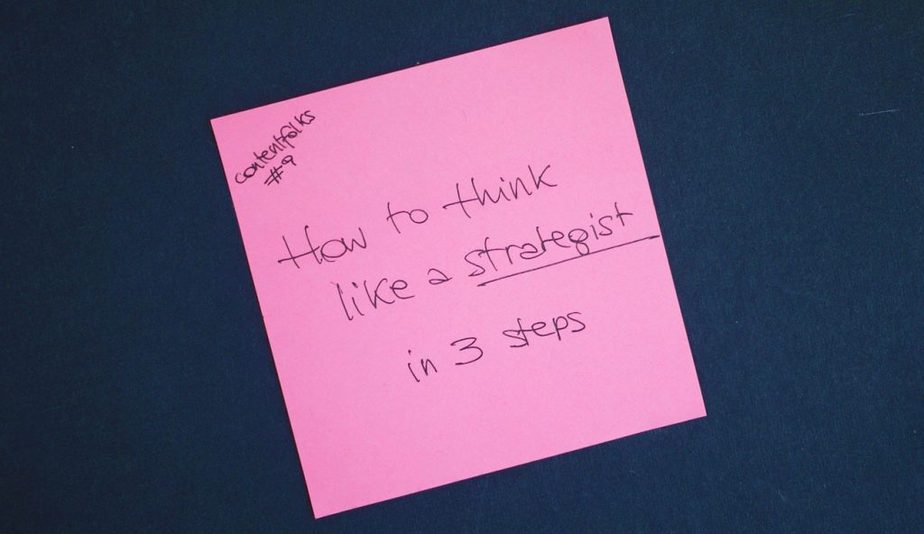
Welcome to contentfolks—a fortnightly newsletter with short lessons & ideas about content that makes a difference, sparks action, and truly serves its audience. Thank you for being here!
Hey you 👋
As a content maker, you likely take a lot of pride in your work—the smooth flow of an argument, the lovely turns of phrase, the witty one-liners.
Your boss or client? Yeah, no, they don’t care about any of that.
What your boss & clients care about
9 times out of 10, CEOs and managers and clients don’t think about content the same way we practitioners do.
They don’t (usually) care if it’s a podcast, a book, or a blog post → these are tactics. They might humour us for 4 minutes as we wax poetic about search intent or Instagram Stories, but by minute 5 what they expect to hear is how the content we produce will solve a business challenge → this is strategy.
Here is something I learned: you make yourself immensely more valuable and employable when you move from ‘just’ delivering like a tactician to also thinking like a strategist.
💡 A practical example 💡
4 years ago, I joined Hotjar as one half of a new content team that needed to come up with a content plan (the other half was Louis Grenier, whom you may also know as a radical differentiation expert and host of Everyone Hates Marketers).
I specialise in written content—so I took a look around, noticed the absence of a well-maintained blog, and had the inevitable “we should have a blog” idea.
Meanwhile, the CEO and Director who had hired us were thinking something along the lines of “we have an acquisition challenge, and Fio and Louis will help us solve it.”
See how NOT on the same page we were? The higher-ups were looking at a growth challenge and expecting a plan to tackle it with content; I was pre-deciding that a blog was the solution to a problem I hadn’t even understood.
Louis, on the other hand: during the first few weeks on the job, he was re-lent-less in trying to diagnose the situation, saying ‘no’ to things left right and center (YouTube? Nope. A podcast? Nope. Ebooks? Nope), and asking non-stop questions instead: What business problem(s) do we have? What does the research say? Who are we targeting? How are we positioning content for them? What is the objective?
After a while, I understood what he was doing and started doing the same. I’m pretty sure it’s because of this mindset shift that people eventually stopped seeing me as ‘just’ a great practitioner and started thinking of me as a strategic partner in growth—with the $$$ and career progression that come with it 😉
Diagnosis → strategy → tactics: a 3-step framework you should use NOW
So how do YOU make this mindset shift happen? I often go back to the 3-step framework below, which works for both overall content plans and individual pieces (which means you can use it in your team and also with clients):

- Start from a DIAGNOSIS phase. Before jumping into offering solutions, you have to understand what’s going on. A few questions to guide you:
– What’s the business challenge we’re trying to overcome?
– Who is the target audience?
– What content resonates the most with them?
– How is existing content, if any, working for this target?
– When people search for [topic] in Google, what do they expect to see?
– Who else is competing with us? - Once you have a sense of where things are, continue with a STRATEGY phase. This is where you define your objectives & where you want to go. A few questions for this step:
– When do we want to see results?
– How will we measure them?
– How will we position content for this audience?
– What overall themes/topics will we use to engage them?
– What will we cover? In how much depth? - At this point, you can finally focus on the specific TACTICS you will use to carry out the strategy and deliver its results. A few questions here:
– Which channel(s) do we focus on?
– What content format(s) do we need?
– What assets should we invest in?
– How frequently do we publish?
This is where you say “we should focus on SEO and long-form pieces.” Or you may have gathered enough data to decide that “we should do Instagram Stories” is the right way forward instead. Both of them are valid tactics—provided you don’t just pre-select one as your mode of execution before doing some research into what problem you’re trying to solve and for whom.
Bonus points to you if you can succinctly articulate all of the above to the rest of the company/your clients, with emphasis on what you’re achieving vs. the tactics you’re using to get there.
Hope this gets you a promotion or raise some time soon! 😉
